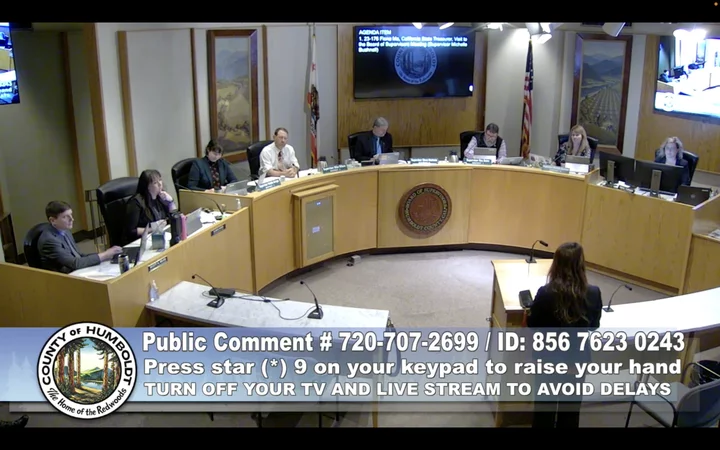The Humboldt County Board of Supervisors. | Screenshot.
# # #
In what was likely her last presentation to the Humboldt County Board of Supervisors before decamping for a new job with the City of Arcata, Tabatha Miller, the assistant county administrative officer and chief financial officer, delivered sobering financial news during Tuesday’s mid-year budget review.
Sales tax revenues have dropped, cutting millions of dollars from the county’s projected income. Planning and Building Department revenues are also down, thanks largely to the collapse of the cannabis industry. And cannabis cultivation tax revenues have stopped coming in altogether due to the board’s two-year suspension of Measure S, eliminating another $3.8 million from the county budget.
With costs simultaneously rising due to inflation, higher employee salaries and more expensive benefits, the county is looking at a $12.29 million budget shortfall next year, Miller said.
As a result, county departments will be asked to pinch pennies, and on Tuesday a pair of department heads urged the board to take the situation seriously.
“I know you all have good poker faces, but I don’t feel the desperation that you all should be displaying here,” Sheriff Billy Honsal told the supervisors. He said his department has federal funds coming in this year to offset a 10 percent budget vacancy, but without that his department would have been down 42 positions last calendar year, not counting 23 un-budgeted positions from the last budget shortfall.
Meanwhile, his department’s liability, risk management and workers’ compensation expenses have all gone up, with increases super-charged by inflation.
“And so I’m sounding the alarm today for us to take this very, very seriously,” Honsal said. He suggested that the board delay allocating revenues from transient occupancy taxes (TOT) and Measure Z until they have a clearer financial picture.
Miller and County Administrative Officer Elishia Hayes said the county needs to reduce the number of trust funds held by individual departments, separate from the general fund. The existence of these funds has been a consistent “finding” from outside auditors — that is, something that should be remedied — and former Auditor-Controller Karen Paz Dominguez often called for these accounts to be reduced.
But Honsal said that most of the $40 million that his own department holds in trust accounts was allocated for specific purposes, including $20 million in public safety realignment money controlled by the local Community Corrections Partnership and another $5 million set aside to offset the cost of new jail facilities.
“And so I’m just here just to remind the board, you have a very difficult job ahead of you,” Honsal said. “We all do.”
Public Works Director Tom Mattson agreed.
“It’s not time to panic, [but] it is time to rein things in,” he said, adding that his own department’s trust funds are similarly encumbered and unavailable for redirection into the general fund.
”It is time to be very, very concerned,” Mattson said. “Focus on our core services [and] be very cautious about expenditures.
County staff recommended that the board assign two of its members to serve on a budget ad hoc committee. Second District Supervisor Michelle Bushnell and Fourth District Supervisor Natalie Arroyo promptly volunteered. The committee will attend departmental budget meetings and participate in the County Administrative Office’s budget compilation.
But the forecast wasn’t entirely doom-and-gloom. “There are some good things happening here,” Miller said. Specifically, she noted that $5 million has been moved into the general fund reserves, which operate as “rainy day” reserves.
Economic Development Director Scott Adair said that the county government’s fiscal downturn is reflected among county residents, too. Last year the county engaged with more than 400 county residents as part of its economic development process and found that people are very concerned about betting their basic needs met, including proper housing, childcare, medical care, education and employment.
The countywide decline in sales tax revenue is likely a reflection of the resulting decline in spending on non-essentials, Adair said.
He noted that there are great opportunities on the horizon, including the development of offshore wind energy, larger state investment in Cal Poly Humboldt and major investments on the Samoa Peninsula, such as Nordic Aquafarms’ recirculating aquaculture system fish farm.
But Adair said those projects, and employers countywide, are facing a labor shortage. The county’s labor workforce participation rate has already declined since before the pandemic, and 3,000 more workers are expected to age out of the workforce over the next decade.
Meanwhile, new employment opportunities are expected to generate 3,000-4,000 new jobs over that same timeframe, meaning Humboldt County may soon have a labor shortage of 6,000 to 7,000, Adair said.
Ultimately, the board unanimously approved staff recommendations, directing Hayes to prepare the budget for the 2023-24 fiscal year while employing a number of belt-tightening measures, including reducing trust and reserve fund balances and limiting requests for general fund money to only those that prevent layoffs while allowing departments to recommend furloughs, hiring freezes and/or staffing reductions.

CLICK TO MANAGE